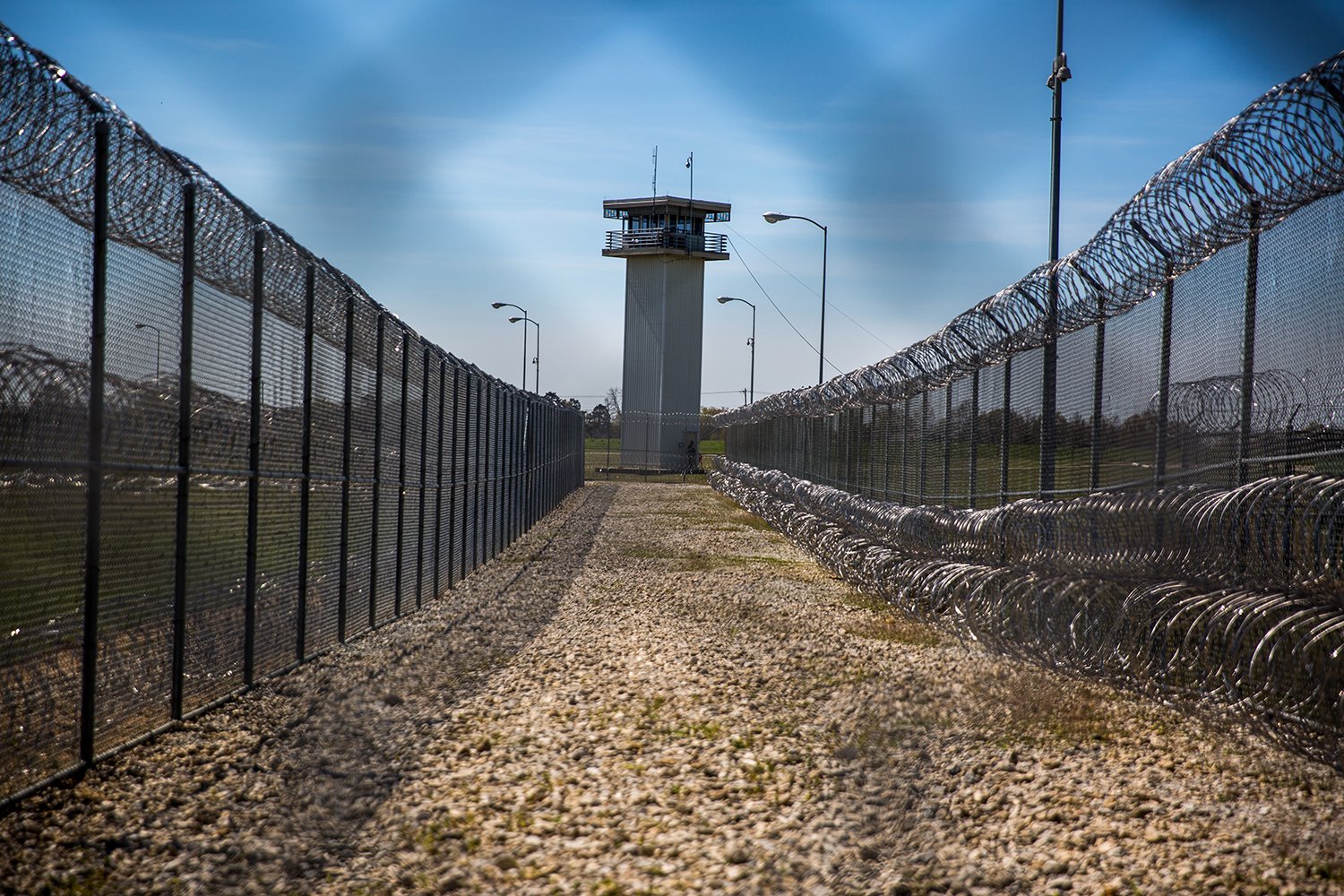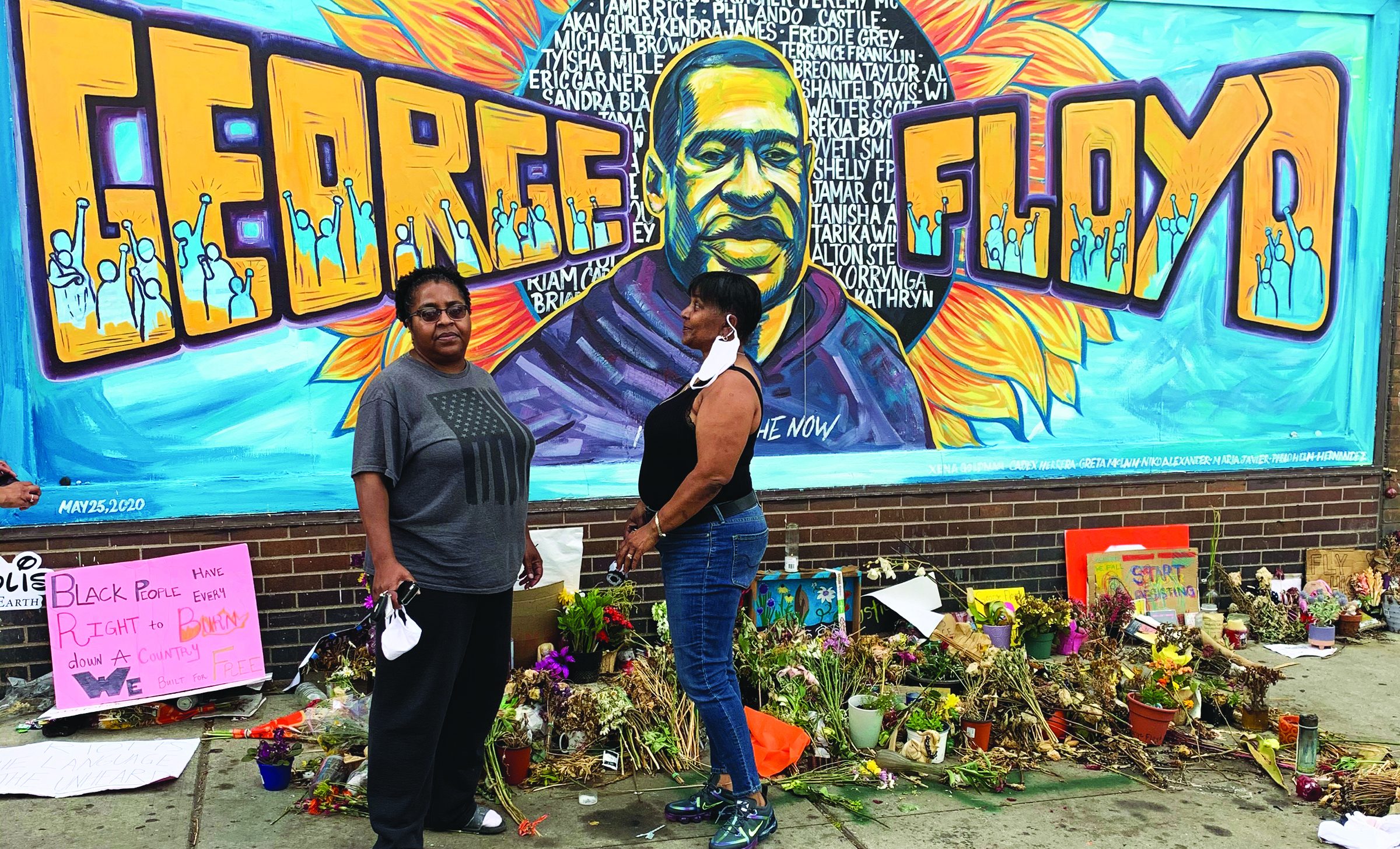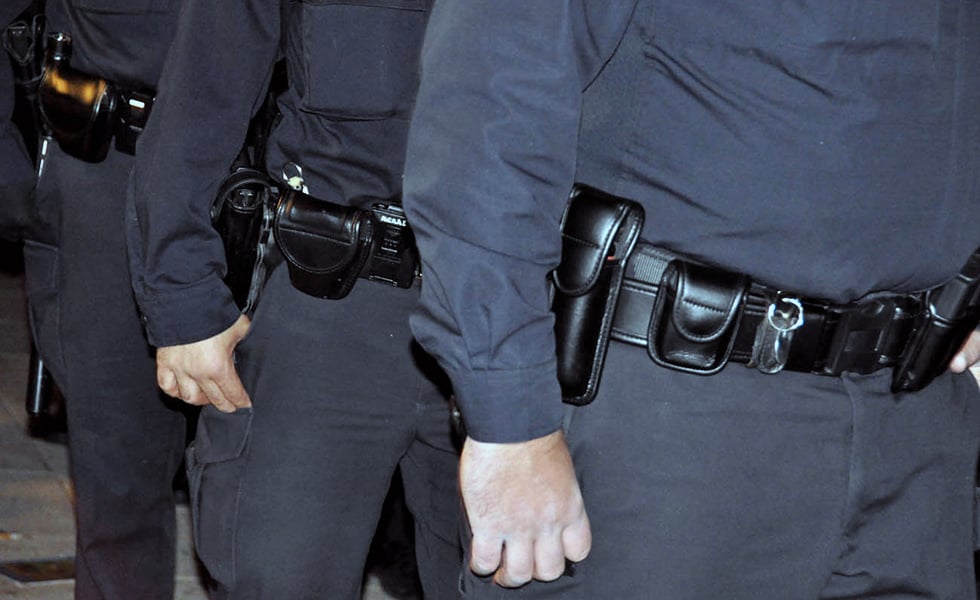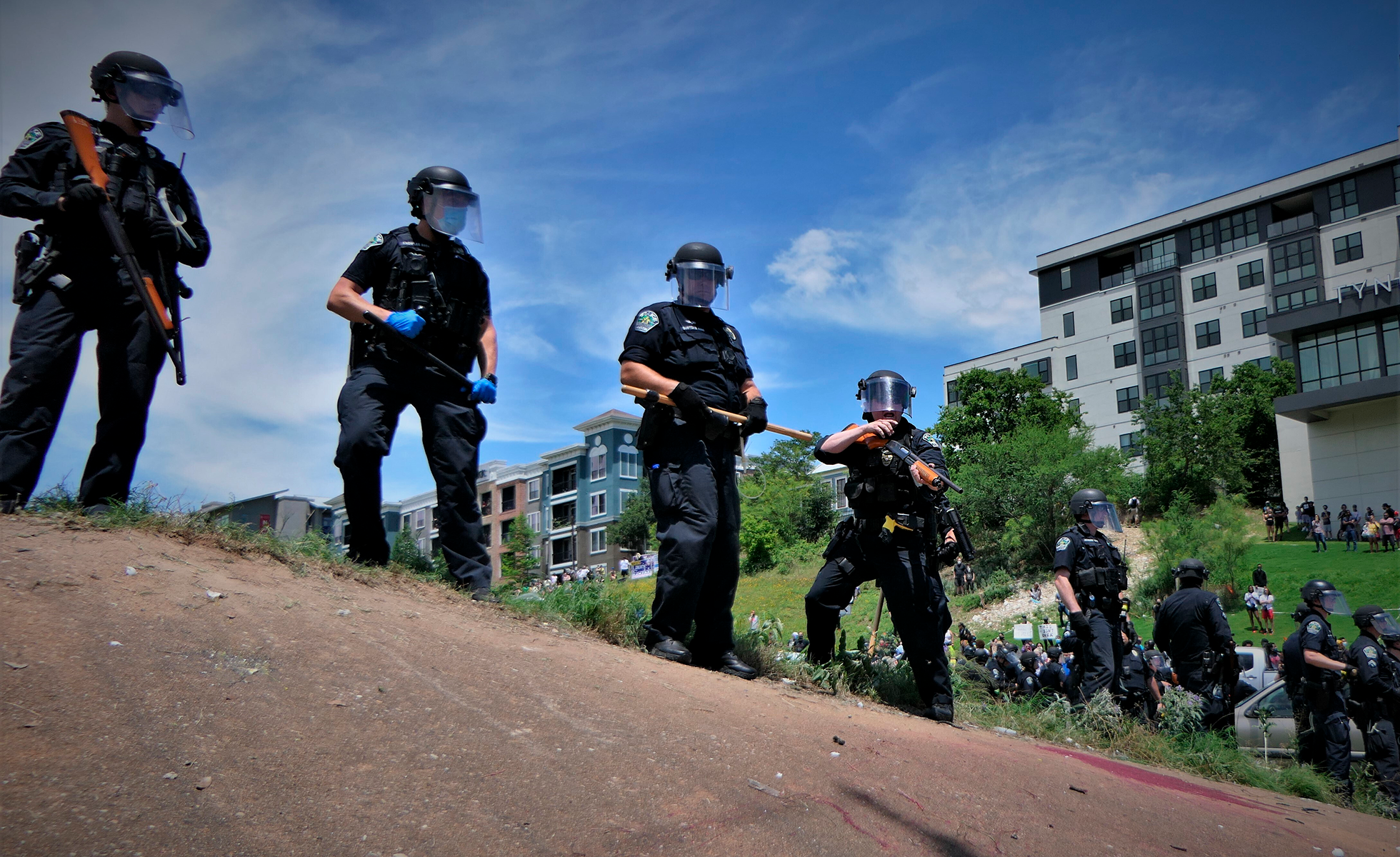
The ‘Culture of Violence’ Inside Austin’s Police Academy
Recent audits of the city’s cadet training spotlight a warrior-cop culture that pervades policing, even in a so-called progressive city.
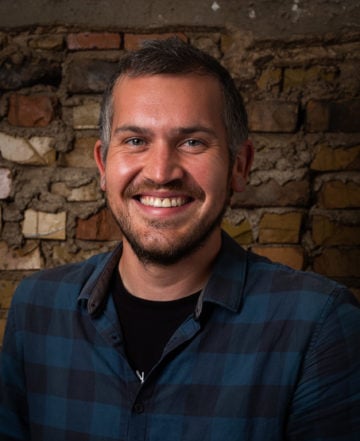
Above: After police in Austin shot “less-lethal” munitions at protesters in early June, there were deafening calls for the firing of Austin Police Chief Brian Manley.
An averted tragedy first made Summer Spisak consider the drastic career change that landed her in Austin’s police training academy. A police officer, she says, “literally saved my family member’s life, essentially by talking them down from committing suicide.” Around the same time in 2016, an ambush in Dallas that killed five officers and injured nine others further inspired Spisak to consider leaving her business operations job at Intel, where she’d worked for nearly a decade. In the aftermath of the ambush, Dallas’ police chief challenged people who criticized the department to apply and help change the profession from the inside, which resonated with Spisak. “I didn’t feel like I was making much of an impact on my community,” she recalls.
Spisak talked it through with a friend, an Austin Police Department (APD) officer who warned that the academy was intense. At about 5-foot-4 and 140 pounds, Spisak knew she wouldn’t exactly cut an imposing figure, even with a badge and gun, but she figured she was athletic enough for the job. “It kind of snowballed into this idea of, ‘Why not me?’” she says. “I’m in good enough shape, I’d recently run a marathon and I’ve run tons of half marathons. I’m healthy enough and fit enough.”
In May of 2017, after a long screening process and months of crossfit training, Spisak left her tech job to begin Austin’s 32-week police training academy. The first day, Spisak says instructors barged into presentations by other trainers to berate the new recruits, “just screaming at us and turning over tables.” They also spent hours running stress drills in the heat—jumping jacks, planks, army crawls, and racing up and down a fire department training tower. Spisak remembers struggling to stay hydrated because of how short and infrequent the breaks were. Instructors barked at them to hurry at every turn. That first day would set the tone for the coming months.
In between the grueling, bootcamp-style drills, Spisak says she was often disturbed by the way instructors talked about police work. One trainer said that people who fight or resist an officer “earned a legal ass whooping.” Others belittled sex workers and people experiencing homelessness. “At one point we were writing essays about why we wanted to be cops, and one of the instructors said, ‘If you tell me that it’s because you want to help people, I’m going to punch you in the face,’” Spisak recalls. “I was devastated, I literally came home and cried that night. That’s exactly why I wanted to be there, why any police officer should be there.”
Three months after training began, Spisak resigned due to a shoulder injury that later required surgery—which occurred after an instructor ordered her sparring partner to “hit her like a man” while practicing take-down moves. Another trainee, Michael Gibbons, who served in the U.S. Navy, also resigned that summer after instructors broke his rib during a gauntlet of sparring matches on his first day learning “defensive tactics.” Jonathan Murray, another cadet injured during training that summer, claimed instructors threatened to terminate him from the academy and blacklist him from any future law enforcement jobs unless he resigned.
The cadets demanded reforms at the academy, sending a letter to city officials recounting how instructors encouraged violence, demeaned recruits, and “regularly disparaged citizens of the City of Austin.” But the city denied their allegations and police officials defended the training. A year later, on October 1, 2018, five police cadets were hospitalized for dehydration and heat-related illness during stress drills on their first day at the academy. One of them, Christopher Wise, spent 30 days in the hospital and accumulated more than $300,000 in medical expenses, according to a lawsuit he filed against the city last year seeking damages, which places blame on “instructors’ refusal to permit the cadets unrestricted access to water.”
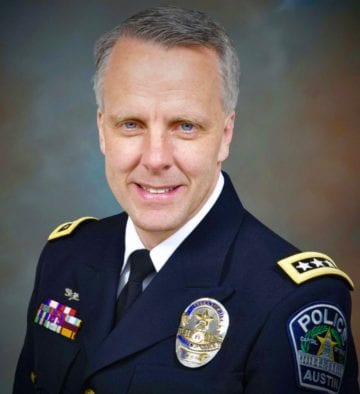
Allegations of racism among APD leadership, which followed a series of other scandals at the department, finally prompted Austin leaders to cancel all new police cadet classes last year and review how APD trains officers. The probe is part of a larger reckoning accelerated by a summer of protests in Austin, a city with outwardly progressive politics but a history of brutal and racist policing. Activists have long said a toxic culture inside APD and regular examples of police violence in the community point to failed leadership at the department. On Friday, APD Police Chief Brian Manley, who didn’t respond to comment for this story, announced that he would step down nearly a year after activists began calling for his resignation.
“Brian Manley has known about all the problems in his police academy for years, and has failed to do more than apply a band aid here and there,” says Kathy Mitchell, an organizer with the criminal justice reform group Just Liberty.
Initial findings from a series city-commissioned reports released over the past year seem to only bolster complaints from former cadets like Spisak and spotlight the kind of violent, warrior-cop culture that pervades much of policing. One group of reports released last summer called APD’s paramilitary approach to training police antiquated, saying it reinforces an us-versus-them mentality toward the larger public. Another report on racial and other inequities in police training released just before the New Year’s holiday warned of a “culture of violence” at the academy. According to that report, “many of the academy’s trainers rely overwhelmingly on ‘violent,’ ‘brutal,’ ‘traumatizing’ practices designed to ‘manufacture soldiers’ rather than produce community-driven law enforcement professionals adept at de-escalation.”
That same report also says that APD’s training division lists only one Black employee out of 57 and that Black cadets in the academy are underrepresented when compared to the population of Austin, less likely than their peers to graduate, and more likely to be injured during APD’s training academy than any other race. Another city-commissioned report released last month found that training videos perpetuated harmful racial stereotypes; nearly half the people shown in the videos interacting with and subjected to violence by officers were Black.
Problems at Austin’s police academy are part of far more fundamental shortcomings in police training in Texas and across the country, where outdated and insufficient training standards contribute to a broken, toothless system for regulating police. Due to the audits of police training in Austin, some local officials say the police academy should remain shuttered until the city can overhaul it, which could mean many more months without a new cadet class. “This has now been months of back-to-back damning reports on how we train police,” says Natasha Harper-Madison, the only Black member of Austin’s city council. “We should take as long as we need to get it right.” Austin Mayor Steve Adler says classes should remain on hold in light of the findings unless APD comes forward with evidence of progress. “All we have right now is these reports,” he says. “And if that’s all we have, I think it shows we’re not ready.”
*
Reforming APD’s training academy is part of a larger project to change policing in Austin. Last year, after a wave of protests against police violence, the city council passed a plan to cut about a third of APD’s $434 million budget. While most of those “cuts” will come from moving some services out from under the police department, such as a new city forensic science department that replaces APD’s old scandal-plagued crime lab, some came from halting new cadet classes, which has freed up nearly $13 million by this point.
Signs have long pointed to an insular, biased, and violent culture inside APD. In 2019, an assistant chief abruptly resigned amid allegations he used racial slurs against Black officers, a Black assistant chief, and a Black city council member. A subsequent investigation released in 2020 found that “racist and sexist name-calling and use of derogatory terms associated with race and sex persists” inside APD, and that top brass often knew about or even participated in such behavior; as a result, according to the investigation, officers who want to improve their workplace fear speaking out due to “almost certain retaliation.” Data reported by the city also shows that Austin police continue to disproportionately stop, search, and arrest Black drivers.
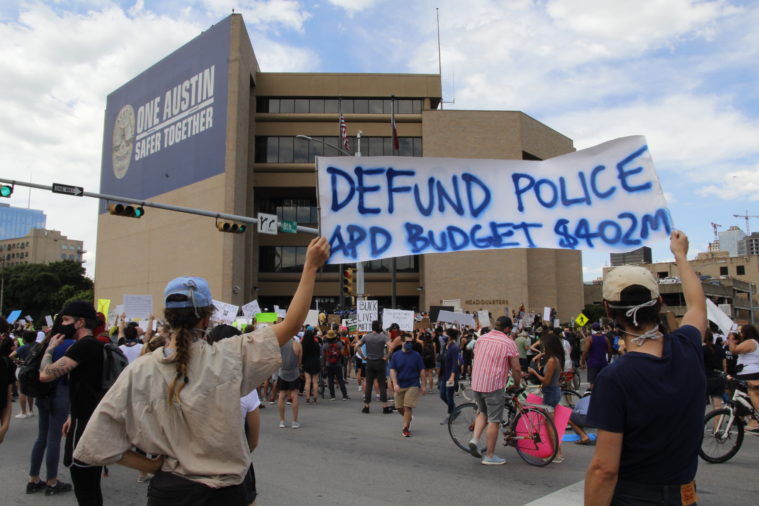
APD officers continue to demonstrate how quickly police can resort to violence. On April 24, 2020, Mike Ramos had his hands up, shouting that he was unarmed, but police fired at him anyway, then killed him when he tried to escape. Later that summer, as people shouted Ramos’ name during protests that erupted across the city, officers fired so-called less-lethal weapons at crowds of unarmed demonstrators, sending several to the hospital. A 16-year-old suffered brain damage after police shot him in the head with a “bean bag round,” essentially a sack of lead pellets fired from a 12-gauge shotgun. Physicians for Human Rights called Austin a hotspot for such injuries during the nationwide uprising following George Floyd’s death.
“I don’t think you can point to one training video and say it caused one specific incident,” says Austin council member Greg Casar, who also maintains that cadet classes should remain on hold until training has been reformed. “But when you see that there’s a problem with how the community’s portrayed in these training videos, when you hear all these concerns from former cadets, when you see so many of the needless injuries and violence against citizens at the protests, it shows a pattern.”
“It doesn’t surprise me at all that we have cadets who become police officers who rush into situations that quickly escalate into shootings. The person they’re interacting with is the enemy, they’ve been primed for that.”
The Austin Police Association (APA), the city’s police union, opposed closing new cadet classes and has long pushed to reopen them, claiming the city has a shortage of officers. The union also blames some recent officer resignations on last year’s budget cuts; at least 77 officers retired during the first 10 months of 2020 compared to 35 during that same time period the year prior. The union is an ally of Governor Greg Abbott, who has vowed to punish cities that “defund the police” and threatened a state takeover of policing in Austin. The APA did not respond to requests for comment for this story.
The Texas Commission on Law Enforcement requires a minimum of 696 hours, or about 18 weeks, of training to become a licensed police officer in the state, less than the training required to license cosmetologists (1,000 hours) and air conditioning repair contractors (2,000 hours). Austin police spend 32 weeks at the academy, more than the national average of 21 weeks for police academy training—but much less than in some other countries. In Germany, for example, police train for at least two and a half years.
While the review of Austin’s police academy is still underway, many of the suggestions that have surfaced in the reports are aimed at pushing APD away from the warrior ethos that has pervaded American policing for decades. The recommendations include abandoning paramilitary-style training, improving the instruction that trainers themselves receive, and getting rid of more than half of APD’s training videos. They also include writing a police academy curriculum that, with the collaboration of community members, explicitly discusses issues of white supremacy, race, gender, class, and other inequities reflected in the city.
“It doesn’t surprise me at all that we have cadets who become police officers who rush into situations that quickly escalate into shootings,” Spisak says about the training she experienced at APD’s academy. “The person they’re interacting with is the enemy, they’ve been primed for that.”
Seth Stoughton, a former police officer who now studies policing as a law professor at the University of South Carolina, argues that any fundamental change in the profession requires a shift in the way officers view their relationship with their job and to the community. Rather than the warrior mindset, where cops are soldiers on the front lines in a battle to save society from the forces of chaos and criminality, Stoughton advocates for steering the profession toward “guardian” principles, such as respect for human dignity, empathy, patience, inclusivity, and introspection. Under the so-called guardian model for policing, fighting crime becomes one small, albeit important, part of a larger public service mission that, Stoughton says, “emphasizes cooperation over compliance, communication over commands, and legitimacy over authority.”
Reforming police culture also requires buy-in from frontline and mid-level supervisors inside police departments, Stoughton says—which will take time and require officers to have uncomfortable conversations with community members who don’t trust police. “The sergeants and lieutenants of an agency the size of Austin PD are ultimately going to have a disproportionate and central role in shaping agency culture,” Stoughton says. “People might get very defensive because you’re talking about something they’ve done for a long time and saying you’ve been doing it wrong for a long time.”
*
Last year, as part of Austin’s multi-pronged review of police training and culture, the city’s equity office chose seven people it considered community representatives to analyze APD’s training videos. For months they watched footage and met with academy instructors to discuss how it was used in training so they could identify and analyze any inequities or stereotypes that they saw. Multiple panelists remember it as a demoralizing experience, in part because the local police union disparaged the panel’s work along the way. The panel’s report to the city says “community members felt endangered while involved in this review process” and alleges that several “were actively threatened by APA representatives.”
Nakia Winfield, a social worker who does anti-racist education, eventually quit the panel in frustration after the summer protests. “It was a lot of emotional labor spending weekends watching what were usually videos of police violence, while on the other hand my community’s out there protesting and I’m deeply concerned for them,” she says. “And then I get in these meetings and the ones I’m supposed to be collaborating with on this panel represent the people who are out there literally shooting protesters. And then I see other police putting shit out there on Facebook and calling us the enemy to rile up their base. I was just done.”
It’s unclear when APD’s training academy might restart. An outside firm hired to conduct a more extensive review of APD’s curriculum isn’t expected to finish until the end of this year. APD says that it’s working with the city manager’s office to determine next steps and, based on the recommendations thus far, has already adjusted training where possible while also planning for “longer term changes” (which changes the department didn’t specify).
In December, Austin Mayor Adler envisioned restarting police cadet classes by the spring, but now he’s unsure of when that might happen. He hopes it’s soon, he says, because “cadets can become important agents for change.”
Read more from the Observer:
-
Undetected: As more homicide cases go unsolved, the backlog of unsolved murders grows and serial killers are free to kill again. Too few police departments are effectively deploying their resources to stop them.
-
The Sunniest City in Texas is Expanding … Natural Gas Production: After New Mexico rejected a proposal for the El Paso power plant, the Biden administration could be El Paso’s last line of defense.
-
In ‘At the Ready,’ Latinx High Schoolers Train to Be Border Patrol Agents: A new documentary tells one story of the border through three conflicted young Texans’ job prospects, and the result is emotional, relational, and hard to categorize.
